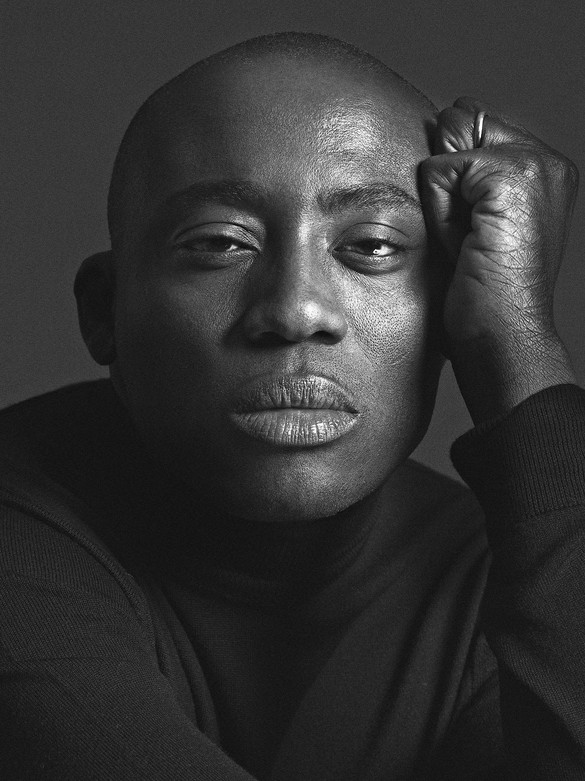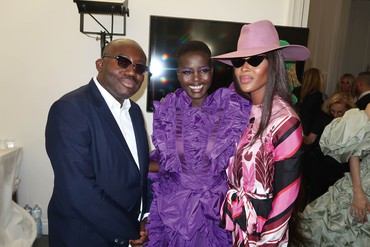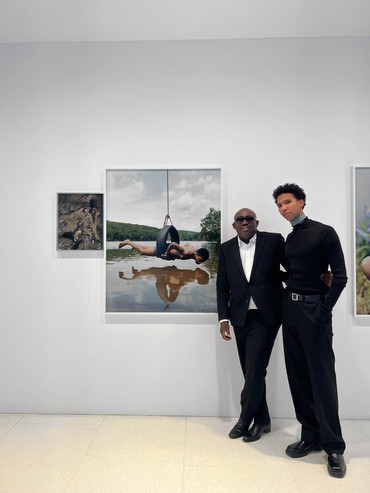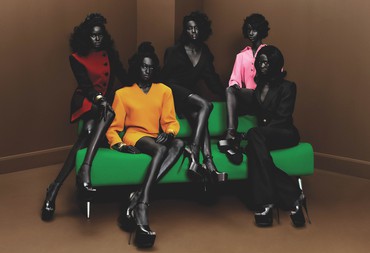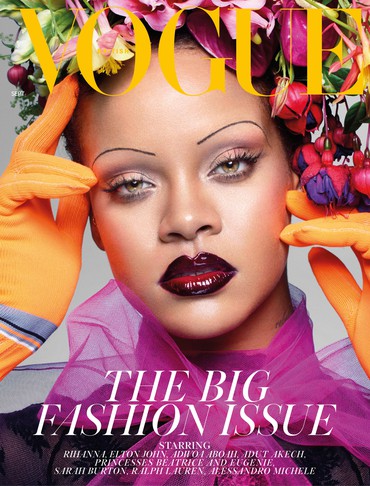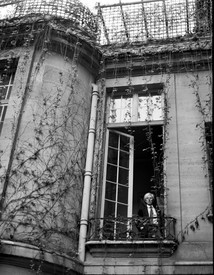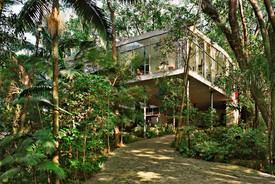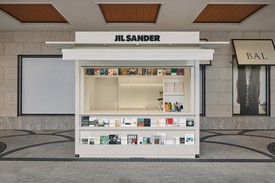
Derek Blasberg is a writer, fashion editor, and New York Times best-selling author. He has been with Gagosien since 2014, and is currently the executive editor of Gagosien Quarterly.
Derek BlasbergWhere are you right now?
Edward EnninfulI’m in London, in my apartment near Hyde Park, staring out the window and talking to you. London Fashion Week’s coming up so we’re all getting very excited. We have lots of young designers, like Nensi Dojaka, who I’m really excited to see.
DBI haven’t seen you since 2022, which was a surreal year. There was so much to celebrate, including a return to what felt like normal fashion weeks, and the publication of your memoir, which we’ll talk about in a minute. But there were also somber moments, like the passing of the queen. When you look back on the second half of 2022, which was also the year you got married, what moments stand out for you?
EEIt was also the year I turned fifty. Even though age seems like just a number, you can’t help but change the way life looks to you. I got married to a man I’ve been with for so long. You were there when we met, all of twenty-one years ago! I published my memoir because I felt that it was time to really share my story with a new generation, as well as people I knew who didn’t know much about my life and how I got here. I often got a feeling that when people look at careers like yours or mine, they think we were always just here. They don’t see the struggles that got us here. But it’s my failures that got me here as much as the sort of great moments or whatever.
DBOftentimes, people think writing a book, or working on a memoir, or turning fifty, or getting married, are therapeutic, cathartic moments. Did you feel that way when you were doing all the things you did in 2022? Was it like therapy?
eeHonestly, I think I was just being stupid, doing them all at the same time! So yes, it felt like therapy, and a lot of it! But more important, it just felt right. When you hit fifty you start to look at your life. I just felt like it was time to do a lot of things I hadn’t done.
DBWhat was the hardest part to write about?
EESome of the bits about my family were painful. Most of my friends know about my journey to sobriety, so talking about that stuff was fine. But the stories about my father were always hard to relive. It’s like, you might be fifty, but you’re only a step away from being a child again when you begin to deal with issues that are so personal. But I knew I couldn’t do a book that just said, We went to this party, we went to that party. We do that every month in Vogue! If I was going to do a book, it had to really be something that was about the struggles we all face every day and how we try to overcome them. I’m not saying I’ve overcome them right now. I’m just staying that every day I try.
DBFor years, you told me you weren’t interested in writing a book. What changed?
EEEverything? covid. Lockdown. George Floyd. These things really changed all—yeah, changed all of us.
DBI read the book twice! I read it once in print before it came out, and then, when you asked me to host a book party for you in Paris, I read it again by listening to it on audio. What was it like to read the book?
EEIt was a trip, definitely. It’s like you’re talking about your life, but you’re a step removed when you read it. At moments I’m thinking, Oh my God, is this too personal? Could I have said this better, should I have said more of this? As you know, I’m never satisfied anyway. I’m never happy with the issue of the magazine, I’m never happy—I’m always looking forward, trying to make things better. But with this book, I didn’t even hand it in until the last possible deadline. I think I actually went over deadline! I kept going back and correcting and correcting and correcting. Eventually I had to hand it over, and when I did, I was very happy. I’m very proud of it.
DBIn the book you talk about the intersection of fashion fantasy and real life, and how your styling process has been informed by reading books and going to art museums. How do you think experiencing other forms of art has informed what you’ve done as a stylist?
EEExperiencing other forms of art is what got me here. Being obsessed with musicians, whether it was Diana Ross or David Bowie, and being obsessed with artists like [Piet] Mondrian, who inspired designers like [Yves] Saint Laurent—that’s what I really loved when I was growing up. I remember standing in front of Monet’s watercolors as a little boy and loving them so much. With my team, I talk about the “big flat,” which is this large space where the worlds of fashion, music, and art all come together. Raf Simons and Sterling Ruby, Kim Jones and Peter Doig . . . fashion and art have always gone hand in hand. [Jean-Michel] Basquiat! Now that’s style. For me, you can’t talk about fashion without talking about other art forms.
DBDo you remember the first museum you went to?
EEThe first museum I went to was the National Portrait Gallery [in London]. I was a little kid from Ladbroke Grove. I didn’t even know that I’d be welcome in a gallery. It wasn’t my world. It’s easy to think that someone who’s successful in this business must come from a world of privilege, but I was from the wrong side of the tracks in Ladbroke Grove, and I remember going to the National Portrait Gallery as a teenager and being amazed that these things existed. And they’re right there! I studied the history of art and when I was young I wanted to have an art gallery. I thought I’d go into the art world before fashion came calling. I remember seeing all these incredible masters in there, and just how beautiful the women looked, and I was just in love—with art and fashion, really, but I saw art with a fashion eye, I now realize.
DBI don’t think you ever shared with me that you thought about running an art gallery. But now that you say that, it sort of informs the way you work. In your pictures, you’re telling a story, you’re creating a collection.
EEFor me, styling is like painting a picture. I can’t just go to a studio and shoot a model looking amazing. There has to be a character. There has to be an inner life. Where did this woman grow up? Where does she live? What does she do? Then the clothes come in at the end. If I don’t know who the character is, Derek, I can’t shoot a story. I can’t just take Naomi [Campbell] or Kate [Moss] into a studio and throw on some clothes and create good pictures. There always has to be a sense of a narrative behind it, a sense of a character behind it. And yes, that was informed by my youth going to museums.
DBSpecifically, Kate Moss has told me about working with you and that you help her create a character in front of the camera, which is why she can do stuff in front of the camera that she would be afraid to do as herself.
EEAll the great models love to be characters. So before every shoot, I’ll call them maybe a few weeks ahead and I’ll say, This is the character, here are some books you can read, here are some things to look at. And then when they come to the set, it’s magical. I really don’t have to do anything on that day but just put clothes on, because the research has been done meticulously. Linda Evangelista—she will ask, What books should I be reading? What artists should I be looking at? What music? And she will come to the studio prepared.
DBAs a stylist, you work closely with designers who are often inspired by contemporary art. When you work with a designer, do you often talk about a recent art show that you’ve seen, or a museum show? How do you see the interplay between art and design?
EETotally. “The big flat.” I love that phrase. Art and fashion to me are inseparable. I don’t style fashion shows anymore, but when I did, we’d constantly be talking about artists and designs. Right now, in London at Tate Britain, it’s Lynette Yiadom-Boakye. I love all these incredible Black artists like Mark Bradford, Theaster Gates. And for me, the best way to inspire a designer is to say, Let’s go see an exhibition. Sometimes you just go in and you get inspired by the colors, you get inspired by the mood, you get inspired by the period. Who knows? Art transports you. Art takes you somewhere. And sometimes I’ve been to galleries with a designer and they’ve come back to the studio and changed their whole collection. Art is about the times we live in and sometimes certain artists can really cut through a moment.
DBDo you remember when our friend Mark Morrison lived at the Oxo Tower and we used to wake up after a long night and go to Tate Modern to work out a hangover?
EEYes! What a wonderful return to reality, not having to really speak and just looking at beauty. You know, the eye must always be fed. What better way to come alive than to revitalize yourself with art?
DBIn this series we ask everyone this question: Do you think fashion can ever be art? Can we ever call designers artists?
EESome designers, yes, create works of art. You can’t look at the greats—John Galliano from Dior—and not see what they do as an art form. True, it might not be exhibited in a gallery—but why not? Making clothes is definitely an art form. You know, you have to deal with colors, you have to deal with shape, you have to deal with textures.
DBThe name that comes up often with that question is your friend Alexander McQueen, an undisputed artist of fashion.
EELee! I loved everything he did. He was so inspired by artists too. You remember, we used to go to so many galleries and it didn’t matter where we went, we’d always end up in some exhibition and he’d pull something out of it and it’d show up in his collections. Art was in his bones. He was obsessed with Joel-Peter Witkin and the guys from the early 1990s, like Jake Chapman, Damien Hirst, Marc Quinn. Lee was part of that whole East London circle. And when you look at his collections, when you see the most beautiful, tailored coat with a horn coming out of the shoulder, how can you not say that design can be art?
DBEdward, I had so much fun at your book parties. Of course I thought the best one was the one—
EEYou threw the greatest book party for me.
DBHa, that’s what I was going to force you to say!
EEYou and Cynthia Erivo did that dinner at Lauren Santo Domingo’s house in Paris, and it was just the perfect night. At fashion week we’re normally running around, but that night was a moment to slow down and take in a moment amongst friends. There are only a few places where you feel totally comfortable and totally yourself, and I’ve always felt that whenever I go to Lauren’s.
DBPromoting a book is a full-time job. What was the craziest moment you had on the promotion tour? I saw you on Graham Norton. That must have been surreal.
EENo, the craziest thing was going to America and doing Good Morning America, doing Trevor Noah, being interviewed by Oprah, doing all these incredible projects with people I’ve respected from afar, and hearing that they liked what I was doing. So the book tour was exhausting, but it was such a great learning experience too.
DBSince you brought her up, tell me everything about being interviewed by Oprah.
EEI love Oprah, but wow, that was so nerve-racking. She was the first person I sent it to.
DBWhat!? What did she say?
EESo she was the first person I sent it to, and I hadn’t heard from her for a week or two, and then I was at Coachella, funnily enough, last year, and the phone rings in the morning, and it’s Oprah. My heart was in my stomach because, you know, Oprah is the queen of books! Beyond! And I’m hanging on every word, begging her to give me any crumbs. And she said to me, You’re a visual person, so I suggest you talk more about the images. Sure enough, I went back there and added the images. She also said she liked the point of it. She wasn’t harsh. I was elated.
DBIt’s kind of incredible to watch you be stopped in the street now and hear from people who were inspired by the book. You know, we were both young kids hustling, and now you’re a role model for kids who are hustling. How does it feel to be an inspiration?
EEI never set out to be an inspiration, but I knew that I wanted to write a book for young kids, because it’s tough being a young person in this day and age, right? When we grew up, there was no social media. We could just go out and have fun. We were being judged in the club by what we wore, but that’s about it. Now there’s so much they go through and I felt that it was just really important to let them know that it’s okay. Imposter syndrome? It’s okay. Failing? It’s okay. Not the best-looking person? It’s okay to be you. So for me, it was really important that I imparted that message and let kids from all diverse backgrounds know that it might be hard, but if you stick at it, something will happen. Magic happens. When I started, it was just me and Naomi and Pat [McGrath] in the 1990s. We had each other. We had support, as Black people, we had support. I want young people to know that they’re not on their own. Now there are so many great examples—if you’re queer, if you’re Black, if you’re from a background that’s not so wealthy, there are all these heroes for you to look up to. It was very important that I showed the kids that it’s okay to be you, it’s okay not to be perfect, even if social media always try to make you think otherwise.
DBMy last question for you in this interview is that there are now so many people who want to be an editor, who want to be a stylist, who want to be the next Edward Enninful. What’s the one tip you give everyone who comes to ask you how to make it in this industry?
EEIf you’re in it for money, give up! Ha! You’re not going to make money for a long time, and you might not even make money ever. If you think it’s a quick career and a quick buck, forget it. Apart from that, you have to be fearless. You’re going to have so many naysayers and you’re going to come up against so many rejections, and you have to just power through. And be original.
DBThat’s three things, not one.
EEThree for the price of one!
